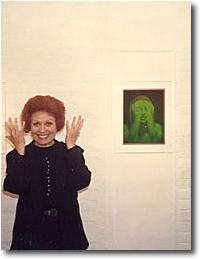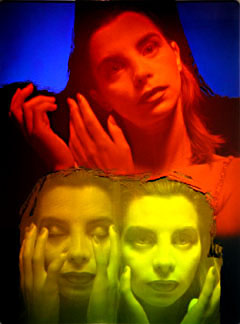

|
3 x 8 +1 Catalogue |
||
|
|
||
| Collection listing | ||
| Artist Statement | ||
| Exhibition Catalogue 1994 | ||
| Gallery 286 Exhibition 2001-2002 | ||
|
|
||
| View other works in the collection [illustrated] [list] |
||
Work shown in the exhibition:
TIGIRL 1985
Reflection hologram and reproduction.
Silver halide on glass.
30" x 33".
Edition # 2/50.
Collections:
Private and public world-wide.
SPLIT BENEDICT 1989
Reduced reflection hologram collage.
3 colours.
Silver halide on glass.
40 x 30cm.
Artist's proof.
Edition size: 25
COSMETIC SERIES:
THE ARTIST
RICHARD HAMILTON
1991
Reflection hologram, flesh coloured.
Silver halide on glass,
43 x 32cm.
Artist's proof.
Edition size: 50.
Collections:
Victoria & Albert Museum,
Richard Hamilton and Jonathan Ross.
View an illustrated list of works by
Margaret Benyon in the Jonathan Ross Hologram Collection.
|
MARGARET BENYON Born Birmingham, UK. 1940 The purpose of my work in holography has been to enlarge the boundaries of what is traditionally seen as fine art. The first phase of my work with holography (1968-1973) was an exploration of those properties unique to the medium. The second phase (1978-1981) was mytho-symbolic, holistic, cross-cultural. The third phase (1981 - 1993) used the human body exclusively, in a personal, almost therapeutic way, using a pulsed ruby laser. Current work (1993- ) explores the naturalisation of holography, and the development of a female aesthetic. My male and female Cosmetic Series (1985-1993) features painted faces. The ideas behind the Cosmetic Series are ideological, socio-political, art-historical, psychological, documentary and personal. |
 In this portrait, holographic patterns on the face of the artist are combined with the stripes on a tiger's head. A vertical strip dividing the tiger's mask aligns both animal and human eyes, to create a haunting image. The light and dark patterns are produced by putting the pulsed laser into "double-pulse" mode. In this portrait, holographic patterns on the face of the artist are combined with the stripes on a tiger's head. A vertical strip dividing the tiger's mask aligns both animal and human eyes, to create a haunting image. The light and dark patterns are produced by putting the pulsed laser into "double-pulse" mode.
TIGIRL 1985 |
| Double-pulsed holography is exciting because for the first time we have a chance to see the contours of our inner and outer body movements. The movement of the subject in between two exposures (twenty billionths of a second apart) is directly visible on the skin. Subtle muscle stress, breathing, the beating of the heart, and in this work a cat-like smile, can be captured. Scientists use the technique for non-destructive testing on machines, but this art work records the lineaments of human emotion. There is an affinity with ancient wooden sculptures, sometimes so worn away that the woodgrain is clearly visible on the face. |
 This is a mysterious and personal work. A young woman hides and reveals her face from behind her hands in three different ways. The woman is collaged as a female trinity, against a deep blue 'sky'. This is a mysterious and personal work. A young woman hides and reveals her face from behind her hands in three different ways. The woman is collaged as a female trinity, against a deep blue 'sky'.
SPLIT BENEDICT 1989 |
|
|
|
An underlying reason why some artists make holograms could be because it is a purer way of connecting up with our really early, pre-verbal memories that are experiences of light. The colour of the sky, that deep blue that seems to resonate in some of us more profoundly than other colours, seems to be the colour of meditation - why else would it feature so often in medieval paintings? Perhaps it is because we can 'see' the ultra-violet part of the spectrum, the hidden part that we can't really see. Perhaps we already 'know' about things that science feels it has to prove, but can't speak about them because they belong to the realm of subjective experience. This hologram is one of a sequence of four holograms made in collaboration with the 'father of pop art', painter Richard Hamilton (UK). It shows a stage of Richard Hamilton's involvement in time with painting on a sheet of glass in front of his face. The sequence shows his initial disengagement, the changes made to the distribution of the paint, his use of the shadows it cast on his face, and the paint drying between exposures. The pink flesh colour of the face is a mixture of four colours produced by swelling the holographic emulsion before exposure. This flesh colour was used to humanise the technology. The piece shows a successful collaboration between painter and holographer. It fits well with Hamilton's computer manipulated Cibachrome self-portraits, and with Benyon's male Cosmetic Series. |
|
Information on this page has been taken from the catalogue: |